#puffin modern classics
Text
Roll of Thunder, Hear my Cry
Roll of Thunder, Hear My Cry - Historical Fiction (Listening to Audio Book)
Mildred D. Taylor
Originally Published 1967 by Scholastic Inc.

Author Mildred D. Taylor released the historical fiction middle grade book Roll of Thunder, Hear my Cry in 1976 and it continues to enrich young readers to this day. I read it initially when I was in middle school over a decade ago and, like many other books I read growing up, I felt I should revisit it and find appreciation for such a stunning book that I didn’t fully recognize when I was younger.
This Newbery Medal winning novel takes place in a country adjusting to the new United States after the civil war, racial tensions still high and potent in the south. We focus on the Logan family and follow along specifically with the daughter Cassie as we witness life and happenings surrounding her family and community over a very turbulent year. We see how the school district treats her and other black students with no buses and poor conditions books passed down until they “weren’t good enough” for white children anymore. We watch as Cassie and her siblings deal with troublesome children in the community as well as adults. We see how far a community will go to get “justice” on a black person who has done them wrong.
In a way, this reminds me a little of Ernest Hemingway’s novel The Sun Also Rises. As his title suggests, and how I find some connection between the two, is that they highlight the going ons of everyday life for a time, place, and people. That this is just how life is in this moment, even if unfair and unrewarding as a reader or someone looking for a just and satisfactory ending to their story. Sometimes, that isn’t how it is.
As this novel was introduced to me as a reading in middle school, I can find myself keeping it somewhere between YA and JUV categories in a collection. This transitional period can be hard to place for people and reading materials so perhaps I would work a “middle” category into my catalog and collection to mark transitional pieces for young readers. There are some difficult matters and language addressed in it that make me hesitant for a children’s collection even if put in a higher reading level area so maybe a YA or Middle grade space with proper labeling.
For me, someone reading this in the wake of the height of the Black Lives Matter movement, it feels very potent and disturbing that these feelings and actions towards people of color persist to this day; how people are being brought up and raised in a way to perpetuate an unjust hatred. Considering I have seen this on banned books lists, the prejudice doesn’t surprise me but disappoints me; the company it shares in these thoughts is revealing.
Speaking of Banned Books, I could definitely see Roll of Thunder, Hear my Cry joining a display of banned materials recorded by the ALA. In a library that I currently work at, a number of the front line books on this display also come with interests in the form of book marks educating readers on why this material has been contested and recognizing the general history of it and its author. I can see Taylor’s novel taking up valuable space with other stunning and notable works in a Banned Books Display. Let’s also not forget when we highlight pride and appreciation of communities, we could also use it as representation for Black History month in February and recommend it as a quick read considering the page count.
I remember having no complaints about this book in Middle school and I definitely don’t now. It is a beautiful book, though sad. I recommend readers take their time with this one considering what happens to the Logan family and their community, especially in the novel’s conclusion. Be well.
- Ray
11/10/2023
Anonymous. (2020, February 20). Banned & Challenged books. Advocacy, Legislation & Issues. https://www.ala.org/advocacy/bbooks
Taylor, M. D. (2004). Roll of Thunder, Hear my Cry. Puffin
Books.Taylor, M. D. (n.d.). Roll of thunder, hear my cry (Logans, #4). Goodreads. https://www.goodreads.com/book/show/310459.Roll_of_Thunder_Hear_My_Cry
#book blog#books#literature#ya#mildred d taylor#puffin modern classics#classics#middle grade#newbery medal#roll of thunder#hear my cry#roll of thunder here my cry#own voices#black author#black books#historical fiction#fiction#banned books
4 notes
·
View notes
Text
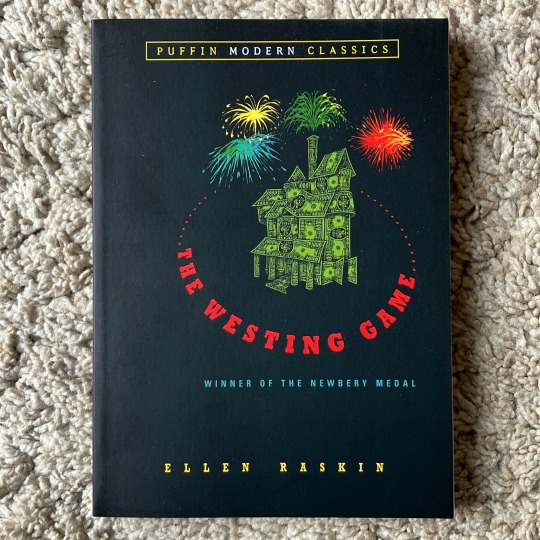
Ellen Raskin: The Westing Game (1978)
0 notes
Text
Want to play old flash games and animations? Here are a few ways.
Note: links are underlined, all links are to webpages except for the two purple links where noted. These link to directly to file downloads. This isn't an install guide, just a list of resources and the occasional tip. Please use caution. I cannot stress this enough. Flash was killed as it had a lot of security issues and a lot of work to fix. Some of these solutions are still just as dangerous as ever.
TLDR Quick Links: Red links are not secure. Use caution.
Ruffle // Flashplayer Executable (needed to run most of the red or orange things) // Waterfox Classic // Pale Moon // Basilisk* // Danknet Explorer // Standalone Player // Newgrounds Player // Puffin Browser // Windows 7 ISO (for flash security, see below, but also be careful. ISO's are dangerous) // BlueMaxima's Flashpoint (actually has a player which I missed. See my reblog.)
Ruffle
Ruffle is a flash emulator that seeks to run flash with higher security than old flash player. This is much safer than the other ways listed below but for now it doesn't have an amazing range. Basically nothing developed in 2010s is certain to run and much of it doesn't work. But it's a cool project so if you can consider donating to them as that can seriously help speed the development along. This is the only Linux solution.
Classic Browsers
There are a few browsers that still support the flash plugin. Since these use the original flash program, they are far less secure than before so please know the risks. Flash was a poorly-sandboxed monstrosity and that has not changed in the slightest.
First, you'll need to download and install flash player: (note: these links will start downloading immediately) Win Mac
(courtesy of Gaia Online. I'm sure they're also archived somewhere.)
Waterfox Classic
Waterfox is a really good browser that I use on some of my computers. It has a really clean UI. Classic, however is similar to the two below. It is also the only apple friendly option (y'all have gotta stop buying apple products I swear to god you're killing indie devs). Do not try to update Waterfox classic as that will remove flash support.
Pale Moon / Basilisk
These two are more or less the same and are developed by the same team(Basilisk is now developed by a different team). They are forked from an old Firefox repository and are built up to work with modern systems. There are differences between them but those aren't really relevant. Both have flash support. In cases where Waterfox classic hasn't worked, these browsers have worked (like for me).
Update: Pale Moon, as I have recently discovered, has a flash sandboxing tool that you can install that was apparently integrated into the browser. You can still use the tool, but they state it isn't necessary. This means that flash should be a lot more secure than it used to be! Pale Moon is perhaps the best option, though note that it still depends on the original flash application meaning that while running flash in Pale Moon is secure other applications could still take advantage of the flash software.
*basilisk is no longer being developed so no idea how long it will last.Basilisk is now being maintained by a different team but as I understand no major features have been added.
Danknet Explorer
Those of you who follow me have heard me bring this up a few times now. I'm working on a clone of the Pale Moon browser that revives old IE6/7 aesthetic and features. Of course, as a result of being a Pale Moon clone, using their exact code base, DNE runs flash also! So, really, this is the best browser to play flash on >.> I'm want the browser to bolster the indie web community so if you are a webmaster or a frequenter of the indie web, suggest a feature through this google form or do so as an issue on the github repository and I'll try to make it happen!
Honorable Mention: Puffin Browser
Puffin is a really safe solution to flash. As far as I understand it they basically play the flash animation/game on their servers and return the results to you. This makes it safer for you as none of the flash stuff is ever handled on your computer. So why did I only give this an honorable mention? I haven't used it myself so I can't confirm anything about it really and I've heard that this is only available through a subscription service. There may also be other limitations. I don't know what's true but I wanted to give it a mention. I just don't know enough about it so you will have to look into that yourself. It felt wrong to not include it though.
Standalone Players
Flash Standalone Player
Flash had a standalone player mostly for debugging. If you download the SWF file of a game you can open it with the standalone player. I think you need the flash program installed so see above. Keep in mind this is also original flash player so it is just as unsafe as with the classic Browsers. Use at your own risk.
Newgrounds Player
Another standalone player, this one is a little nicer. Probably recommend it more than the official flash one. No certainty on how sandboxed it is.
Final Note
For future proofing, consider downloading and setting up a Windows 7 virtual box and running through that. Action/timing flash games will suffer a lot but at least many games will be playable via the above methods. If you want to get around action/timing game issues consider dual booting an old system or getting an garbage laptop that runs an old windows version. Here's a Windows 7 iso from internet archive.
Windows 7 also has security issues since it's past end of life so use cautiously. Safest bet is just to have it on a completely different system.
All you have to do now is find things to play
Feel free to reblog with anything I've missed
#flash#tutorial#shockwave#adobe flash#old internet#old web#2000s internet#y2kcore#internet nostalgia#2000s web#early internet#webcore#ruffle#pale moon#basilisk#flashpoint#waterfox#old tech
798 notes
·
View notes
Text
Ten modern Dracula covers, rated
(by request of @mysticalspiders on my previous post of older covers)

A poor start from Penguin Classics, who seem to have confused their Dracula with their Nosferatu for this 2006 edition. Piddling little castle too. 2/10.

I had to look at this 2013 Vintage Children's Classics edition several times before I realised that their Dracula does not, in fact, have a man-bun. I'm a bit disappointed, and also adjusting the contrast settings on my laptop. 7/10, hope this unabridged edition leaves the children suitably traumatised.
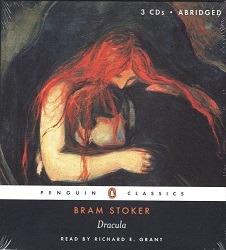
Fair warning, we're going to see a lot of covers from assorted Penguin imprints - this is the 2003 audiobook (read by Richard E Grant, which sounds delightful) but the print edition had the same cover. It's Love and Pain by Edvard Munch, also known - not by him - as Vampire. Gains points for thematic relevance, loses them again for not depicting a specific scene in the book. 6/10.

I like this (Penguin Vintage Classics, 2011). It's subtle, it's a little bit sexy. It has the confidence that the reader knows what Dracula is about (after all, who doesn't?) and will put things together for themselves. 8/10.

More Penguin Vintage Classics, this time from 2007 (I did warn you). I'm getting strong vibes of the 2020 BBC Dracula, and the less said about that the better. 3/10.

OK. I might need to be a bit petty here. I get what they were going for at Modern Library Classics in 2002, I really do, BUT I do need to note that Lucy did not wear a crucifix on her choker. (She wore a diamond buckle, given to her by Arthur). She very much did not wear a crucifix on her choker. The story might have gone rather differently had she worn a crucifix on her choker. 4/10.

I'm a bit conflicted on this one. On the one hand, I like Edward Gorey, whose Dracula stage designs illustrate this 2021 Sterling edition. On the other hand, I'm not at all sold on the wings, and my favourite Edward Gorey illustrations are his wolves, e.g. in his cover for The Wolves of Willoughby Chase. There are wolves in Dracula, there could have been wolves here. 7/10, would have been 9/10 if it had wolves.
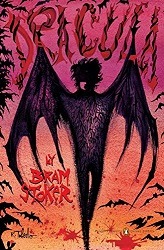
The art style on this Penguin Classics Deluxe Edition (by Ruben Toledo, 2010) reminds me a great deal of the art style of a girl I had a crush on when I was at school. So it gets extra points for bringing back happy memories. And it needs those points, because otherwise Dracula-as-Edward-Scissorhands is decidedly Not For Me. 3/10.
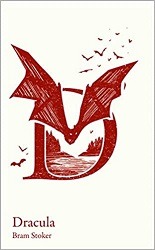
I mean it does the trick, doesn't it? Nothing to write home about, nothing to complain about. Except that this is a Collins Classroom Classics 2021 edition - for the A-level set text, no less. Can you imagine hoofing this back and forth from your house to your locker to your classroom, every day for a term or more? Can you imagine how revolting this off-white cover would eventually become from months-long exposure to school desks and teenagers' rucksacks? No thank you. 4/10.

It's BLUE!! Thank you, Puffin Clothbound Classics (2019), for finally providing an end to the monotony of red and red-tinted Dracula covers. There are a lot of covers that follow the castle-and-bats motif, and I haven't included most of them to keep this from getting samey. But imagine having the strength and courage to say no to the endless tyranny of red and make it blue. BlueBLUEblueblueblue. I feel refreshed, I feel restored. 20/10.
89 notes
·
View notes
Audio
(Literary License Podcast)
Welcome to a captivating episode of the Literary License Podcast's Book to Screen series, where we delve into the enchanting world of Roald Dahl's children's classic, "The Witches". Join us as we embark on a thrilling journey through the book's spine-chilling realm where child-hating witches and humans coexist. This episode offers a comprehensive exploration of the book's plot, critical reception, and notable adaptations, unveiling the unique blend of humour, fright, and moral lessons that mark Dahl's storytelling.
Joined by passionate reader Leandro Ghezzi, we discuss Dahl's distinctive portrayal of witches and draw parallels between the characters and real-world figures. We also tackle the controversy around the modifications in Dahl's books by Puffin Books aimed at appealing to modern audiences and delve into the changes made in "The Witches". The conversation extends to a comparison with the original Grimm fairy tales, and the impact of their dark and ambiguous endings.
Engage in our riveting discussion around Dahl's creativity, the debate over censoring his books, and the enduring charm of his dark tales that have influenced generations. We explore the enduring appeal of classics from authors like Dr. Seuss and Roald Dahl, debate the perspective of viewing old works through a modern lens, and express concern over attempts to modify books in the name of political correctness.
We also provide an in-depth review of the 1990 film adaptation of "The Witches" starring Anjelica Huston and discuss on how Dahl's narratives have been translated on screen. The debate explores the age-old question – do children’s literature and film adaptations really need happy endings? Ride along on this literary exploration as we delve deeper into the magical world created by the prodigious author, Roald Dahl.
00:00:00 - Once Upon a Time; 00:06:27 - Plot Synopsis; 00:12:09 - Thoughts on The Witches; 00:31:52 - Unique Writing Style; 00:32:45 - Reflecting on Childhood Reads; 00:43:40 - Dark and Timeless Tales; 00:44:21 - The Witches (1990 Film); 00:45:29 - Fantasy Adventure Begins; 00:46:31 - Childhood Memories; 00:50:36 - Dahl’s Emotional Reaction; 00:53:12 - Ambiguous Endings Discussion; 01:01:18 - Personal Connections; 01:02:29 - Rating The Witches; 01:04:54 - Angelica Houston’s Character Origin; 01:06:11 - Upcoming Episodes Preview; 01:07:15 - W.I.T.C.H by Devon Cole
0 notes
Text
0 notes
Text
In Praise of Sensitivity Readers
by Don Hall
The kneejerk reaction to the very concept of sensitivity readers going through a work of literature and suggesting changes in the language written by authors long dead in order to revise and soften the potential harm these books might cause others is to throw up my hands and bellow "What the everloving FUCK?"
Agatha Christie mysteries written between 1920 and 1976 have had passages reworked or removed in new editions published by HarperCollins to strip them of language and descriptions that modern audiences find offensive, especially those involving the characters Christie’s protagonists encounter outside the UK.
The edits cut references to ethnicity, such as describing a character as black, Jewish or Gypsy, or a female character’s torso as “of black marble” and a judge’s “Indian temper”, and removed terms such as “Oriental” and the N-word. The word “natives” has also been replaced with the word “local”.
In the new edition of the 1964 Miss Marple novel A Caribbean Mystery, the amateur detective’s musing that a hotel worker smiling at her has “such lovely white teeth” has been removed.
Puffin did something similar to the collected works of Roald Dahl and now Ian Fleming's James Bond is getting the wash-over. Many changes are to remove racist language. In Live and Let Die, Bond’s comment that would-be African criminals in the gold and diamond trades are “pretty law-abiding chaps I should have thought, except when they’ve drunk too much” has been changed to “pretty law-abiding chaps I should have thought”.
Others are to remove sexist language; for example a scene where Bond visits a nightclub in Harlem, and a reference to the “audience panting and grunting like pigs at the trough” has been changed to “Bond could sense the electric tension in the room.”
James Bond without sexism?!
Not dissimilar from tearing down statues of Confederate Generals or renaming high schools previously named for statesmen with shady pasts, this practice seems like a strange revision of history as well as an odd work around to actual censorship.
On the other hand and upon reflection maybe the practice has some benefit after all.
The first question is why engage in this washing of the past? Simple. To erase the reminders that people were solidly racist and sexist in attitudes back in the day. To eliminate references to fat people because fat people don't like being reminded they're fat and to cross out any notion that cripples were in any way less than the non-crippled. To keep these classics—which we know will continue to be read because they've lasted the test of time—more inclusive. No one black should ever be confronted with the horrors of slave owning white people and no woman (you know, the ladies without cocks) should ever remember a time when they weren't girl bosses and not seen as property.
The second question is why would this be a good idea?
Think of it. History exists to understand the past so we don't repeat the failures and celebrate the triumphs. The discourse of the sensitivity readers ultimately leads to an erasure of that history so that two generations from now, no one will even know how horrible writers, politicians, and scientists could be. Sure, these future generations will wonder what all the fuss was about concerning social justice and will only see the Civil War as a fight for the economic autonomy of the Southern states because references to slavery will be scrubbed clean. These generations will not understand who Harvey Weinstein was or hear about McCarthy and the HUAC. They won’t understand that blacks had to struggle through Jim Crow America and won’t be amazed when a guy whose legs were blown off in a war can play basketball because we’ll all be exactly the same.
They will be adult children. It will be the Disneyfication of history and literature and art. How grand ignorance will be. How easily other countries will dominate and control them.
"Mommy? Why did Hitler kill the Jews?"
"He was bad. He didn't like them."
"But why?"
"He was like Donald Trump except with better manners. Stop asking questions. Questions like yours are why we were so dysfunctional back in the early 21st century. Go watch your vintage Frozen and the re-release of Song of the South."
"Uncle Remus was just a kindly person of advanced age, wasn't he?"
"Yes. Now stop with the questions and go plug in. I need an opioid."
1 note
·
View note
Text

I’m quite pleased about this, but it’s a shame that it took such an outcry to make them see sense.
My view is that if any publisher wishes to “update the language” in their books to make them more acceptable to modern readers, then this is perfectly fine, as long as they are honest about it.
When they bring out a “modernised edition”, they should say so. They should ensure that the “classic” versions are also available and at a similar price. That way, the purchaser can make a fully informed and fair decision.
What I don’t like under any circumstances is the way that Puffin brought out new, completely rewritten versions without saying anything to anybody. In my opinion this is rewriting history, and is censorship on a par with what was done in the Third Reich when the books were burned. It is unacceptable and it is patronising in the extreme, and should not be done.
The situation we now have is that both modernised and classic editions are available. This means that any woke person will be able to choose the version that suits them and not be offended, whilst normal people can buy the classic version and enjoy it as it was meant to be enjoyed.
There is still a cynical voice inside me which says that Puffin have seen an opportunity here. Why not sell both versions and make even more money!
Whatever, the restoration of the original versions can only be a good thing.
0 notes
Text
Purchase Anne Frank's The Diary of a Young Girl at Booksvenue
Introduction
The Diary of a Young Girl BY Anne Frank is the first-person account of one young girl's experience of the Holocaust. It is both a touching personal story and a historical account that represents an important piece of history.
The Diary of a Young Girl, also known as The Diary of Anne Frank, is a book of the writings from the Dutch-language diary kept by her while she was in hiding for two years with her family during the Nazi occupation of the Netherlands. In 1942, with the Nazis occupying Holland, a thirteen-year-old Jewish girl and her family fled their home in Amsterdam and went into hiding. The astonishing diary of Anne Frank, which was found in the attic where she spent her final years, has become a classic, serving as a chilling reminder of the atrocities of war and a moving monument to the resilience of the human spirit.
Visit: https://www.booksvenue.com/catalog/product/view/_ignore_category/1/id/14975807/s/the-diary-of-a-young-girl-definitive-edition-puffin-modern-classics/
The Diary of a Young Girl by Anne Frank has captivated readers for years with its tragic and inspirational depiction of an ordinary life lived in extraordinary circumstances. A foreword by Night author Elie Wiesel is included in this Penguin Classics edition, which was edited by Otto H. Frank and Mirjam Pressler and translated by Susan Massotty.
Millions of young people throughout the world have read Anne Frank's Diary of a Young Girl since it was first published more than 60 years ago. In an Amsterdam warehouse, thirteen-year-old Anne Frank and her family took refuge in July 1942 as they fled the occupation. For the next two years, Anne writes in her diary about her growing-up thoughts, feelings, and longings, as well as the difficulties of living in such close quarters. When they were all betrayed in August 1944, her diary came to an abrupt end.
The Diary of a Young Girl, justly famous as one of the most moving and important documents to emerge from the war, is also a timeless, universal story of the inner lives of ordinary people. And it remains as urgent today as when it was first published nearly sixty years ago: perhaps even more so. Like Anne Frank herself, this book is unique and unforgettable.
Who is "The Diary of a Young Girl's" author?
Anne Frank is one of the most widely read, influential, and widely translated books in the world. Written during her two years in hiding by a young Jewish girl who died at Auschwitz, it was first published in 1947. The Diary of a Young Girl has been adapted for stage and film.
Interesting Facts about the book
The Diary of Anne Frank is one of the world’s most widely read books, and its impact on contemporary consciousness has been compared to that of Uncle Tom’s Cabin. The Diary of a Young Girl begins on June 12, 1942, when Anne Frank received a diary for her thirteenth birthday. This is the second volume of two that are based on her diaries and journals (the first volume was The Secret Annex) after she went into hiding in 1942. Even though the diary stops abruptly when she and her family are arrested on August 4–5, 1944, it has outsold every other book except the Bible.
This Definitive Book restores important material removed from the first edition, providing us with a better insight into Anne Frank's life. Anne is revealed to be more human, more sensitive, and more vital than ever via her interest in her developing sexuality, her disagreements with her mother, her affection for Peter, a kid whose family had hidden alongside hers, and her perceptive portrayals of her fellow captives.
This remarkable diary also expresses the story of a young girl’s experience during two years in a secret attic apartment in Amsterdam — an experience so terrible that as you read about it you realise that happily ever after will never again be possible for any of us. It makes you live through this child’s experiences until at last she was liberated by death from hell on earth. And yet those who read it — those who can put themselves back into this time and place and thus imagine themselves actually there — gain a new appreciation of what freedom means to all civilised people today."
Discover Anne Frank's most awaited book, "The Diary of a Young Girl." with Booksvenue. Pre-sales begin at www.booksvenue.com
Use gift coupon Books12 for an instant 12% discount.
More than 15 million books
0 notes
Quote
A girl's dreams, like her life, should be sweet and filled with honey.
Jane Yolen, The Devil’s Arithmetic
#national jewish book award#jane yolen#the devil's arithmetic#girl#dreams#sweet#life#puffin modern classics
4 notes
·
View notes
Text
Facts about the characters in the Plague Doctor comic book. Facts taken from ASCfm the writers of the Plague Doctor comic book
Sergey Razumovsky
Height 185.
Sergey can't fence, but he loves knives.
Because of sitting at the computer ruined his eyesight and wears lenses not just for color.
At 'Vmeste" he has introduced a corporate ethic to address him informally and by name.
Seryozha is very skeptical of modern literature and loves Pushkin (russian poet)
Seryozha likes pizza, depending on his mood, the most varied: both gourmet and cheap.
In principle, he is an omnivore and does not turn his nose up at anything edible, but is very fond of beautiful serving.
He likes chocolate bars of all kinds.
Sergey continues to make sculptures.
He is a good shot and has been practicing for a very long time (since Major Grom)
Seryozha does not like swearing, Oleg is indifferent to it.

Oleg Volkov
Height 190.
During his school years Seryozha forced Oleg to read a lot of books, but now Oleg is more accustomed to reading than to perceiving information in a different way. He prefers text recipes to video.
Oleg is a fan of European cuisine, but even though he can cook anything he likes, he is more inclined towards meat and ethnic cuisine.
He was an economics major. That is, economist, accountant, and other related education.
Oleg first killed a man somewhere in the Special Forces, before his career as a mercenary.
As he grows older, Oleg finds only the sweets and desserts he has made himself tasty. Occasionally he condescends to some very expensive and delicious sweets, plus he loves fruit.
Dreams of getting a dog.
Continues to smoke even after his lungs are shot.
There was a brief episode in Oleg's life when he was a gamer, but a very brief episode
Oleg is indifferent to art and classical music, but understands them by virtue of the fact that Seryozha was constantly rambling on about them in his youth. Oleg was always telling Sergei about pokémon and rock bands
Oleg would not have been thrilled to be called Olezha, because it was childish.
The writers did not confirm that Oleg was Tatar 😔
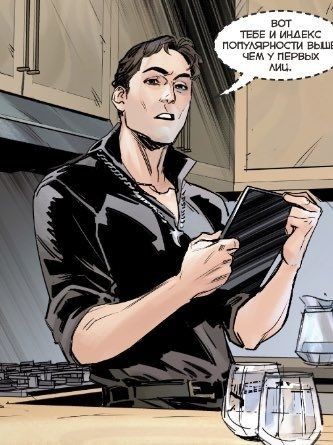
Lera Makarova
She didn't have a prototype.
Lera's height is 179.5
She is a fifth year medical student.
Loves listening to sounds of nature and audio of whales singing.
Loves soups and broths, steamed food, does not like heavy home-cooked food with lots of fried, lots of fat.
When she was in school she got A's and B's.
Prefers natural makeup, does not do it every day, but knows how to make up.
Before she met Seryozha and her total fatigue, she liked to run in the morning.
Her ex-boyfriend's name is Artem.
Lera has a book "Witcher". On her bookshelf she has "Dubrovsky" by A.S. Pushkin and "Kamaleinik's Flower" by O. Gromyko.
Lera is 5th dan in kendo, which means she is at least 23 years old. Kirya (Lera's brother) is 2 years younger than Lera.
Her parents don't mind that Lera does kendo, and her family supports her.
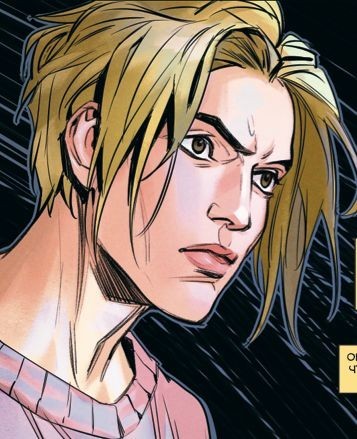
Vadik
Height 190.
Vadik is 35+ years old, never called Dragon in canon.
His car is a Jeep Cherokee.
He has a perfectly legal driver's license, he didn't buy it.
He has an ethnographic interest in all national cuisines and always tries to taste the local food when he visits a particular country. The more unusual the dish, the more interesting it is. In St. Petersburg he is a fanatic about the local puffins.
He can cook, but without any soul or fanaticism.
Dolph Lundgren was offered as an example of the artist's appearance.
He studied at the Department of History and Theory of World Culture. Defended his doctoral dissertation.
Not against animals, but he can not afford to have one.
Only one tattoo, but it's a big one, occupying the upper torso and shoulders.
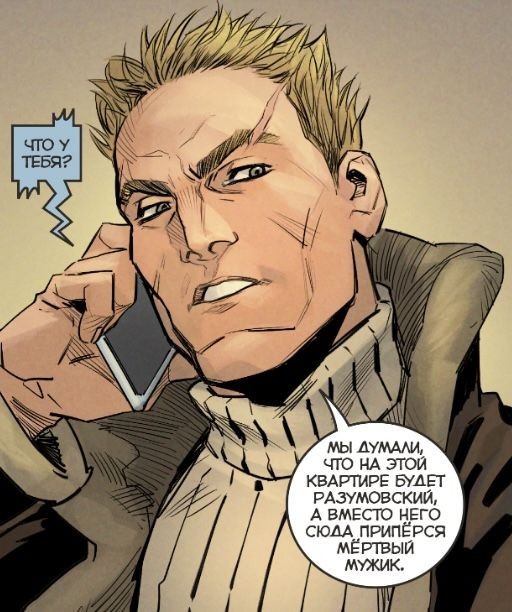
Altan
His height is 182.
After the explosion and the wrecked car, he has pins in his legs.
Altan is a Buddhist, like the rest of his family.
Wears things with his neck covered, collars and scarves, and is a fan of gold inlays and epoxy
At home he may be in shorts, t-shirts, and a bathrobe, but those who saw him like this would die.
Nemetaphorically can buy up wilted roses for 50 rubles, just so they don't die.
He studied bioengineering at ITMO, but was forced to graduate from another university.
He and his sister are half-siblings: the mother is the same, the fathers are different.
He never saw his father or his sister's father, as his sister's father died a long time ago and his own father abandoned Altan's mother before he was born.
He is a club-goer (in fact, he asked to go to Hong Kong just for that), but has become quieter with age.
Doesn't like to ride in the front passenger seat in a car.
If he wants to offend Dragon, he'll say Gaga's country album sucks.
Likes to walk on the shore of the Gulf of Finland.

#major grom#major thunder#plague doctor comics#sergei razumovsky#oleg volkov#serovolk#lera makarova#valeria makarova#vadim#altan
262 notes
·
View notes
Text
Baldwin Colletion--Alice in Wonderland
Presented is Arthur Rackham’s illustrated edition of Lewis Carroll’s Alice’s Adventures in Wonderland, containing drawings from 1907. There were only 1,130 copies of this edition printed (this particular one being number 822). This edition is filled with realistic yet expressive drawings depicting Alice’s journey through Wonderland, filled with mostly black and white drawings and some drawings with small color palettes that bring Alice’s story to life.

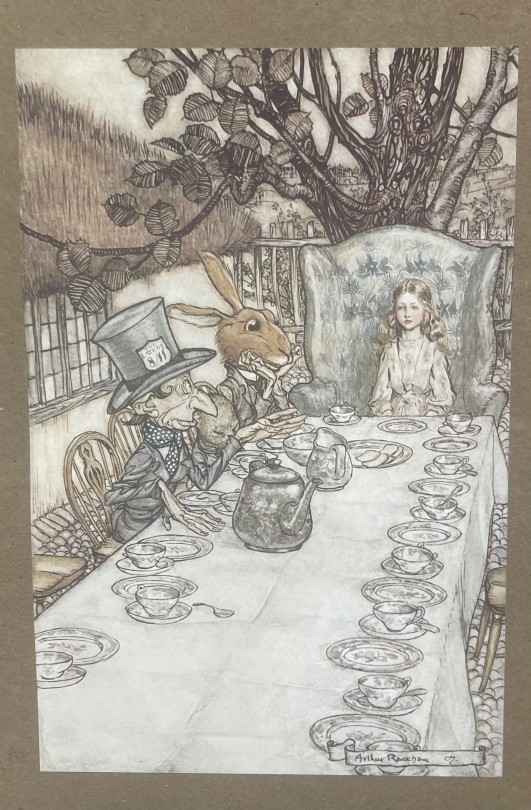
This particular edition of Alice’s Adventures in Wonderland truly encompasses the spirit of the Golden Age of children’s literature. Apart from the fact it was completed during that era, the style of the illustrations captures the essence of how children’s literature was at that time. The drawings depict Alice and the setting and characters of Wonderland in a slightly more mature vibe. However, the drawings still manage to be imaginative because of how detailed they are. Here, Rackham presents a clear idea of how he envisions Wonderland as a serious yet whimsical setting, with hyper-realistic plants and animals yet charming portrayals of the different humans, such as Alice, the Mad Hatter, and the Queen of Hearts. Since children at this time were starting to be seen more as children rather than miniature adults, this work highlights how while there is still a sense of maturity within these illustrations, a child’s imagination is still taken into consideration.
These illustrations being the bridge between children being taken into more consideration is shown in comparison to previous and later versions of the story. In the original illustrations by John Tenniel from 1865, the year Alice’s Adventures in Wonderland was first published, the drawings are more in the style geared towards an adult.
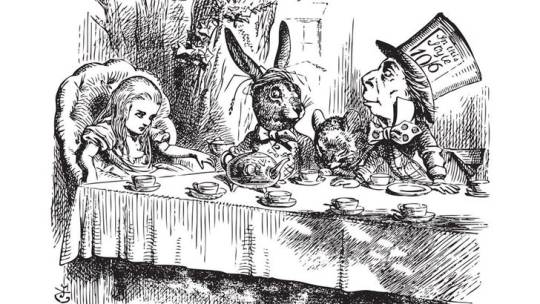
Though similar to Rackham’s illustrations (which makes sense given how they’re still within the Golden Age), these drawings completely lack color and are overly detailed. They do a great job at bringing the characters of Wonderland to life, but not quite the way a child would. Rackham’s drawings are slightly less detailed and contain more color as mentioned previously. Rackham’s drawings mark the beginning of the shift of Golden Age depictions of children’s stories.
More modern depictions of the story (i.e., beyond the Golden Age) show how there was a complete shift in the way Wonderland and its characters are depicted. Take a look at the Puffin in Bloom edition of the book (2015).
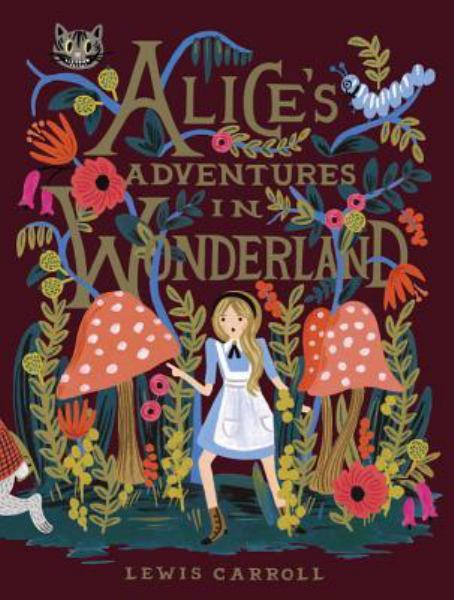
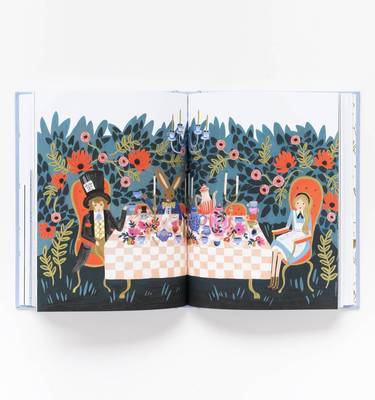
These drawings are much more geared towards children by appealing to their senses. Bright colors that pop, whimsical shapes, and fun interpretation of classic scenes. This specific edition is vastly different from the older versions since the detail isn’t realistic, and none of it is in black and white. It goes to show how far interpretations of this story have come, this version being the epitome of an edition that fully takes children into consideration.
We see how Rackham’s illustration fully encompass the Golden Age of children’s literature. But no matter what edition of Alice’s Adventures in Wonderland we see, there is no doubt that each version does the job of doing Wonderland and all its elements justice.

3 notes
·
View notes
Text
Allow me to introduce my shelf...
My fiction is all impeccably organised alphabetically by author. My non-fiction and medieval stuff and anything that doesn’t neatly fall into a category? It’s Big Chaos. So much chaos. Allow me to introduce those less-often-photographed shelves...
First off, a quick overview:

Now to break it down. First up we’ve got this wonderful pair of shelves here, featuring on the top row my old books (of varying degrees of antiquity and disrepair), and on the bottom, a variety of classical and medieval texts from the Odyssey to Bede:
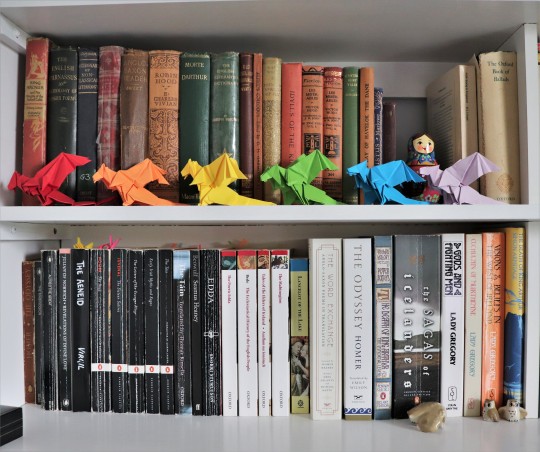
Most of these are things I’ve studied, hence the proliferation of index tabs (some of them have them down the side instead, so you can’t see them here). They’re organised approximately by publisher, with a couple of annoying exceptions: Penguin Classics, (Oxford) (Faber & Faber) (?), Oxford World Classics, Norton, Penguin Deluxe Classics, Colin Smythe, (Faber & Faber). The exceptions are mostly to keep things grouped -- both Táins are next to each other, and the two Eddas are next to each other, with Beowulf between them because it seemed vaguely appropriate, I guess.
To the right of those two we’ve got this pair of shelves. The top row features a collection of old Puffin children’s books, mostly from the 60s and 70s. The bottom row features language-related books.

The Puffins are alphabetical, as much as space allowed, but the bottom shelf is... a little bit more chaos. The Irish stuff is vaguely chronological (Old Irish giving way to modern Irish; books as Gaeilge by publication date), with the dictionary at the end to hold them upright. The Welsh stuff got shoved down the end with the book on conlangs, not because Welsh is a conlang, but because this shelf is big chaos in general.
Below those, we’ve got the weird shelf, which houses all of my ‘other’ non-fiction (e.g. not history, languages, or medieval stuff), plus religion...
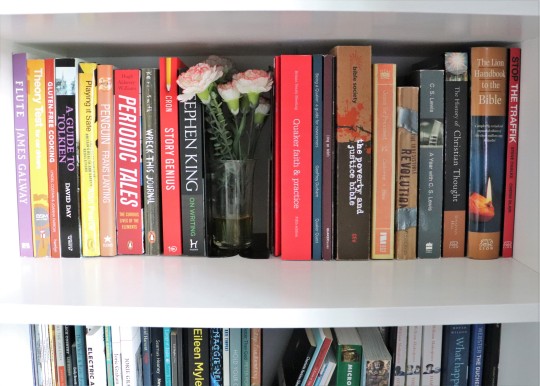
These are organised mostly by publisher and approximate topic. And below it, just visible, you can see the ‘weirdly sized’ shelf, which features poetry (to the left), assorted small books (in the middle), and plays (Shakespeare and Webster) to the right. I didn’t manage to get a better picture of that shelf.
On the left hand side we have the bulk of my history and medieval section, which ranges from “really good academic books” to “bad mythology books I got when I was twelve and can’t bring myself to chuck out”, so there are a few here where their presence on my shelves shouldn’t be taken as a recommendation...

(In particular, if you’re into druids, I’d instead recommend Blood and Mistletoe: The History of the Druids in Britain by Ronald Hutton.)
These are by height and also kind of by publisher? With the second shelf down, more academically rigorous books are to the left of TW Rolleston. Note also two recensions of the Táin on this shelf. (One day I’ll be able to have all my Táins on the same shelf, but it is not this day.)
Below that, not visible on the original shelfie, there’s another shelf of more history stuff that didn’t fit here, most of it oversized/tall:
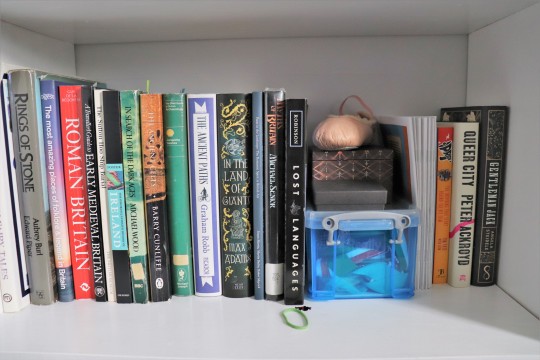
At least, that’s what the left hand side is. The right hand side features the entirety of my modern history stuff, which is pretty much all queer except for one book, Bad Blood by Colm Toibin, which you can’t even see here because it’s hidden behind those back issues of Gesta Asnacorum (the student magazine of the ASNC department).
To the right of that, below the shelf of weirdly sized things and poetry, is the real oversized shelf, featuring a bunch of huge hardback fiction books plus a handful of graphic novels (two of which are in Irish). On the bottom left shelf is magazines and still more oversized material, and on the bottom right is children’s picture books that I’ve kept, a photo album, and a few arts & crafts books I’ve hung onto. But I don’t have photos of any of those.
And on the top shelf of the whole lot is the overflow fiction shelf, but it can only fit paperbacks or very small hardbacks due to the height of the shelf.
So that’s my nonfiction! It’s horrendously organised, tbh. I’d like to do it properly some time, but I’m limited by the height of the shelves -- Rolleston can’t be on the same shelf as the rest of the old books because it’s too tall, ditto Stories From The Táin being separated from the rest of the language books; I can’t have all my books as Gaeilge together because two are graphic novels and one’s a picture book and they won’t fit on a shelf that size, etc etc....
How do you organise your non-fiction books?
16 notes
·
View notes
Photo
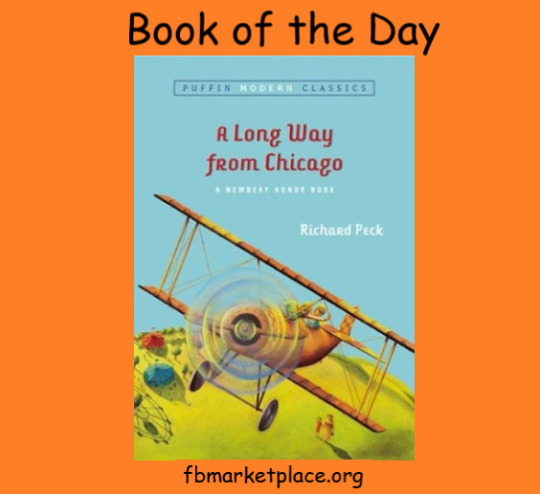
#A Long Way from Chicago#Richard Peck#A Long Way from Chicago by Richard Peck#Puffin Modern Classics#summer books#first book#First Book Marketplace#books to kids#kids in need#bookstokids#kidsinneed
0 notes
Photo
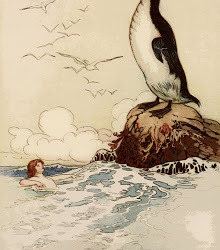
FRIDAY, 22 MARCH 2019
LATE SURVIVAL OF THE LOST AUK? GAREFOWL, GREAT AUKS, AND A PARADOX OF PENGUINS
And there he saw the last of the Gairfowl, standing up on the Allalonestone, all alone. And a very grand old lady she was, full three feet high, and bolt upright, like some old Highlandchieftainess. She had on a black velvet gown, and a white pinner and apron, and a very high bridge to her nose (which is a sure mark of high breeding), and a large pair of white spectacles on it, which made her look rather odd: but it was the ancient fashion of her house.
Charles Kingsley – The Water-Babies: A Fairy-Tale For a Land-Baby
As fondly commemorated above in Charles Kingsley's classic children's novel The Water-Babies: A Fairy-Tale For a Land-Baby (1863), one of the most famous extinct species of modern-day bird is the great auk Pinguinus impennis, also known as the garefowl, gairfowl, or geirfugl. Almost 3 ft tall (the only taller auk was the prehistoric Howard's Lucas auk Miomancalla howardi), this sturdy flightless black-and-white seabird from the northern hemisphere was superficially reminiscent of the southern hemisphere’s familiar penguins, but its link with them does not end there – because the great auk was the original penguin, the latter name having been initially bestowed upon this puffin-allied species. Only later was it applied by those European sailors first penetrating Antarctic waters to the wholly-unrelated birds that they encountered there and which retain it today, long after the original northern penguin’s extermination.
The great auk once existed in tens of millions, nesting on the rocky coastal areas of islands on both sides of the North Atlantic, but it was in America that it first met its end. Its feathers were prized for use in eider-downs and feather beds, its flesh was tasty and therefore much sought-after by sailing vessels, and collectors coveted its eggs, and so this imposing but helpless bird was massacred in countless numbers. On Funk Island off Newfoundland, for example, its precious nesting grounds were frequently raided and mercilessly desecrated. Thousands of auks were captured alive and cooped together in great enclosures like domestic fowl until it was their time to be slaughtered en masse by being clubbed to death and then thrown into furnaces, enabling their feathers to be more readily removed from their bodies. By the second decade of the 19th Century, the great auk was merely a memory in North America.
In Europe, its major stronghold was the Icelandic coast, but great auks even existed around the more northerly islands of Scotland, most notably St Kilda but also visiting the Orkneys, with one particularly famous Orcadian pair being nicknamed the King and Queen. Sadly, however, they were no safer from hunting here than they had been in the New World. Moreover, it was especially ironic that as this species became rarer, it became ever more persecuted by museum collectors - anxious to add specimens and eggs to their collections before it died out! The last known pair of great auks constituted a couple that were clubbed to death (and their egg smashed) on the Icelandic island of Eldey on 3 June 1844, since when the species has long been deemed extinct (but see below). A particularly moving novel reconstructing this terrible, shameful event, entitled The Last Great Auk and first published in 1964, was written by Allan Eckert, and was reviewed by me here in an earlier ShukerNature post.
The Last Great Auk by Allan Eckert – Collins hardback 1stedition, 1964 (© Allan Eckert/HarperCollins, reproduced here on a strictly non-commercial Fair Use basis for educational/review purposes only)
For some decades thereafter, however, various quite convincing reports of lone living specimens emerged from various remote far-northern European localities, and it is with these little-mentioned, 'post-extinction' reports of great auks that this present ShukerNature article is concerned.
3 notes
·
View notes
Text





🌍 The most charming seaside holiday destinations in the #UK 🇬🇧 and #Ireland 🇮🇪 🌍
🌟 Prices from £50pp* for 2-3 Nights
👉 1. Introduction:
There’s nothing quite like a hit of fresh sea air. At any location in the UK 🇬🇧, we’re lucky to be no further than 70 miles from the sea. An estimated 3 million people live by the coast, so for the rest of us, there are seaside holidays.
In the summer, the coastal atmosphere is electric, with endless days to splash about or soak up the sun with a gripping book. In winter, you can rug up on a chilly morning to catch the sun rising over the bay, or head to the local for a satisfying serve of fish and chips.
While Brits have long been lured by the sun-drenched days of the Canaries, the past year has reinvigorated our appreciation for our vast and varied coastline. According to a recent UK Staycation Index, 62% of Brits will spend their 2021 summer holiday in the UK. Moreover, half of the most sought after locations are by the seaside. The great British seaside holiday has made its triumphant return, and here’s where you need to go…
👉 2. #Beaumaris, #Wales 🏴:
According to the UK Staycation Index, North Wales topped the list for the most popular UK holiday destinations, beating out long-time favourites Cornwall and Devon. If you’re yet to experience the striking scenery of this part of the world, we’d recommend basing yourself in Beaumaris. This charming seaside destination on the Isle of Anglesey will tick many of your holiday boxes, offering history, scenery, cuisine, and swimming opportunities.
Initially a Viking settlement, Beaumaris became part of a series of fortifications when Edward I ordered the construction of Beaumaris Castle in 1295. This incredible, symmetrical structure is a UNESCO World Heritage site and is just waiting for you to visit. Outside of the castle lies the town, with its fascinating combination of Georgian, Victorian and Edwardian architecture.
Wind your way through the modern cafes and pubs and head for the glittering seafront. On the way, enjoy a delicious local treat at Red Boat Ice Cream Parlour or venture out to the pier, where boats depart for the seabird sanctuary of Puffin Island, where you can spot puffin, guillemots, razorbills, and kittiwakes.
👉 3. #Swanage, #England 🏴:
If your idea of a holiday is one based around food, then you can’t go past Swanage. The town market takes place every Friday and you can pick up some fresh delights at the Purbeck Produce Market on every second Saturday of the month.
Swanage is home to all the classic charms of a seaside town, including a quaint harbour, bays for swimming, amusement arcades, and local fish and chips shops. You can relax on the Victorian pier, or take things up a notch with some water sport activities including sailing, canoeing, and pedalo.
To dive deeper into the area, take a break from the sun with a stroll through the Swanage Museum and Heritage Centre, where you can gain a insight into the local history. History buffs might like to ride the historic Swanage Railway to visit the nearby Corfe Castle – it’s the ideal day out.
Beyond the delights of the town, what makes Swanage a dream holiday destination is its proximity to some of the Jurassic Coast’s most stunning locations.
👉 4. #Portree, #Scotland 🏴:
While Portree is considered to be the capital of Scotland‘s Isle of Skye, it lacks the hustle and bustle of a big town. And that’s why we love it. Sure, it’s home to plenty of amenities including cafes, restaurants, supermarkets, bookstores, a cinema, but ultimately it’s a quiet base to explore the isle.
The town is known for its colourful and picturesque harbour, with pink townhouses and old fishing vessels bobbing by the footpath. Better yet, the peaks of Ben Tianavaig, Suidh Fhinn and Ben Chrachaig are visible from the town, adding to the natural tranquillity. If you’re looking to explore the surrounding areas by sea, boat cruises regularly operate from Portree.
👉 5. #StHelier. #Jersey:
Feel like you’ve seen enough of the UK? Then venture a little further to the Channel Islands. St. Helier is Jersey’s largest settlement and only town. Foodies will be drawn to the town centre, where there’s the Michelin-starred Bohemia, a luxurious, art-deco space with high-quality dining, and Street Food Thursdays, a collection of delicious, local street food traders.
Aqua lovers will find paradise at Havre des Pas, a sandy beach on the fringes of St. Helier. The bathing pool is filled by the tide each day, giving swimmers a safe area to take a refreshing dip. Beautiful period buildings dot the seaside promenade at this spot, adding a nostalgic tinge to your beach trip.
If you’re feeling adventurous, board the castle ferry or stroll across at low tide to Elizabeth Castle. The fortification, based on a tidal island, has defended Jersey for more than four centuries. The castle offers secret rooms, hidden passageways and bunkers to explore, as well as sweeping views of the gorgeous bay and Jersey’s south coast. For more thrills, take to the breakwater and wander until you reach the stony, single-room chapel that is St. Helier Hermitage.
👉 6. #Dingle. #Ireland 🇮🇪:
If you’ve always dreamed of exploring an archetypal Irish seaside town, get yourself to Dingle. The town is on the edge of the Dingle Peninsula, located on the southwest coast of Ireland’s Wild Atlantic Way. From the town, you can explore the Slea Head Scenic Drive, a 30-mile route of coastal views, verdant hills, and dramatic peaks. A short drive from Dingle is Inch Beach, a stretch of soft sand where you can spot birds, stroll along the dunes, or even head out for a surf.
Like many coastal towns, there’s a famous local spot for ice cream. If you’re looking for a sweet treat, sample the handmade goodness of Murphy’s Ice Cream on the colourful Strand Street.
📨 Be the first to find out about some of our fantastic offers by signing in to our newsletter (you can opt out anytime) here https://www.facebook.com/WLJ2015/app/100265896690345
☎️ 07510 802413 or 01902 900897
📩 Direct message us https://www.facebook.com/WLJ2015 or website chat https://worldlifetimejourneys.com/
*T&Cs apply. Subject to availability.
100% Financial Protection guaranteed. ATOL/ABTA/TTA Protected. TTA member Q5786
Holidays 🌞, tours 🌐 and cruises ⛴ at excellent prices!
0 notes